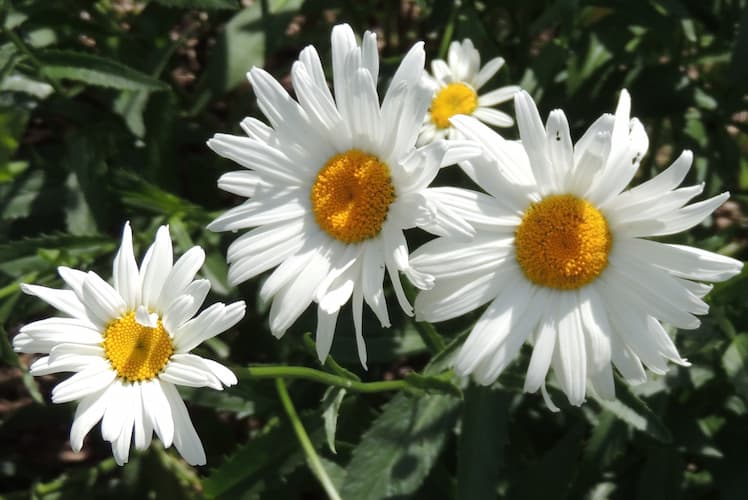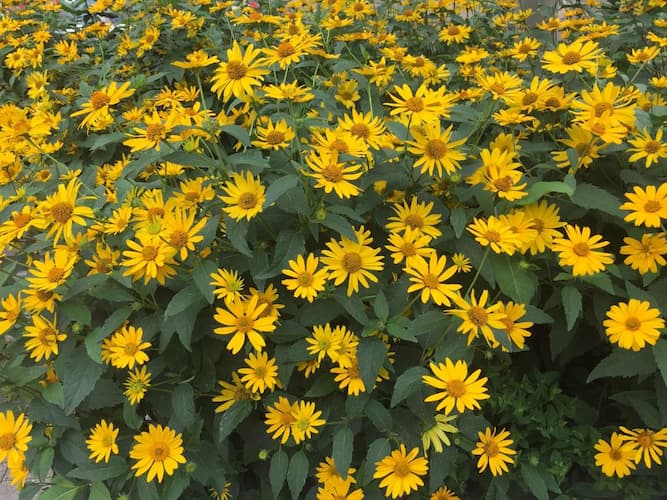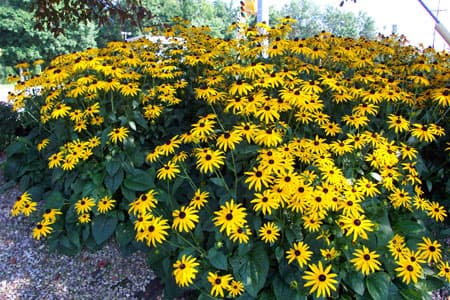How to Grow Daisies Perennial Flowers

About Growing Daisy Flowers in Your Home Garden
Growing Daisy flowers is easy. Low-maintenance perennial daisies brighten up the flower garden wherever they are placed. And they look great in indoor vases and floral arrangements. As cut flowers, they are long-lasting, too. Take your pick! There are dozens of cheerful varieties to choose from. They are among the most popular flowers of both gardeners and homeowners, to decorate the yard with continuous, long-lasting blooms. And they are perfect for beginning gardeners and those whose thumb has not yet turned green!
We consider these flowers among the best for kids and beginners.
Also, the flowers grow well in flowerpots on your patio or deck.
Daisy Plant Specifications
Flower Colors: Depending upon the variety of daisy, there’s almost all of the colors in the rainbow. And, there’s many bi-colors. too.
Flowers Bloom: Summer to Fall
Plant Height: from just 6 inches to 3 feet, depending upon variety.
Light Requirements: Grow plants in full sun.
Ideal Soil pH: 6.0 – 8.0.
Hardiness Zone: 4 – 9. It varies somewhat by variety.
Toxicity: Most varieties are non-toxic. However, some varieties are toxic to humans and pets.
Deer Resistant?: Yes
Invasive?: While they do spread out from their planting site, they are not considered invasive plants.
Native To: Varieties are Asia, Europe, and North America.
Number of Species: There are over 40 species of Daisy flowers.
Plant Type: Annuals and Perennials
Botanical Name: Chrysanthemum maximum (Asteraceae)
Common Varieties of Daisy Flowers
Shasta Daisy – perhaps the most popular, a perennial
Gloriosa Daisies – They are daisy-like. But, they are not daisies.
Painted Daisy
African Daisy (an Annual)
Pyrethrum Daisies
Many, many other varieties
Are Daisies Edible?
YES and NO! Not all daisies are edible. So, you need to explore which ones are edible, and which are not. They belong to the Asteraceae family, which includes lettuce and other edible greens.
For edible varieties, the petals have a somewhat bitter taste. They are used in salads and as an attractive garnish. The leaves of edible varieties are eaten in salads.

Medicinal Uses for Daisy Plants
Geologists found evidence that Ancient Romans cultivated Daisy plants for medicinal applications as early as 2,000 B.C. Some daisy plants offer a wide range of medicinal treatments. The trouble is, you need to know which species offers what specific benefit. SO, you need to do your research before you use daisies medicinally.
Here are some of the potential applications:
- It alleviates migraine headaches.
- Use it for kidney failure and kidney stones.
- It is used as a treatment for liver and gall bladder problems.
- Researchers believe it fights breast and lung cancers
- Use it to treat hepatitis.
Light Requirements
Daisy flowers grow their very best in full sun. Give them 6 – 8 hours of direct, bright sunlight.
Light or dappled shade will cause the stems to grow lanky, making them susceptible to wind damage. Also, it can result in fewer blooms.
Perennial Daisy Flower Propagation
These plants are grown from seed. Annuals will bloom in the first year. For perennials, start Daisy seeds in year one, and they will bloom the second and each following year. Daisy seeds can also be planted in late summer or early fall for flowers next year.
Also, you can start plants indoors, 6-8 weeks before the last frost date for your area.
Days to Germination: 10 – 21 days, depending upon the variety.
Plants can also be propagated, division. Dig up plants, separate them into clumps, and re-plant the clumps.
Plant Spacing: Plant daises 14 inches apart. This may seem a bit too much for a plant that looks its best in groups. But, it won’t be long before these quickly spreading plants fill in all of the gaps.

How to Grow Daisies
Daisies are among the easiest plants to grow. Established plants need very little attention during the year.
The plants grow best in rich, well-drained soil and full sunshine. But, they are a hardy and forgiving plant. They will readily tolerate poorer soils and partial shade.
Apply a general-purpose fertilizer in the early growth stage. It helps the plants to develop big and strong stalks and leaves. Just before blooming, provide a fertilizer high in Phosphorous, to help promote big, bright blooms.
Like many other plants, daisy flowers grow best in evenly moist soil. They do not like extended periods of soggy soil. However, they do tolerate occasional dry soil. For best results, water deeply and regularly during extended droughts.
Staking plants is sometimes required, especially if grown in partial shade.
After the first frost in your area, cut the plants down to ground level. They do not need mulching for winter protection.
Did You Know? Daisies can be found growing on every continent in the world, except Antarctica.
Days to Germination: 10 – 21 days, depending upon the variety.
Pruning Daisy Flowers
Prune the plants as needed. Keep vigilant for sick and dead leaves and stems. This keeps the plant healthy and attractive. If your patch of daisy flowers is dense, thin them out a little. This gives the remaining plants more sunlight. And, the increased air circulation helps to avoid plant disease,
Deadhead spent flowers to promote continuous blooms. After the initial bloom, cut the plants back several inches. This will remove unsightly dead blooms and encourage a second blooming.
Insects and Plant Disease
Daisies seldom are bothered by insects and disease. Generally, these plants do not need insecticides or fungicides.
If insect or disease problems occur, treat them early with insecticidal soap and /or fungicide.
Also see: Plant Problems – Identify the causes and find the cures.
Overwintering Daisies
Different types of daisy flowers are overwintered in varying ways. Of course, annual varieties will succumb to the first frost in the Fall. Some perennial varieties can be cut at or near ground level. They will resume growth in the spring. If you do not cut them to the ground, in the Fall, prune back dead grow early in the spring before they awaken for the season.
Non-hardy perennial varieties can be overwintered in a flowerpot in a sunny window of your home. Slowly acclimate them to indoor conditions to avoid leaf drop. See: How to Avoid Leaf Drop.
Related Articles
People who read this article will also like:
How to grow Daisies – by Garden Hobbies
Deadheading Spent Blooms – Deadheading encourages some plants to produce new blooms. And, it gives a neat and tidy plant appearance.
Please support our site. Shop for:
- rmmatthews100@hotmail.com
- 585-721-6528
- Rochester, NY
©1999-2024 GardenersNet.Com, All Rights Reserved

